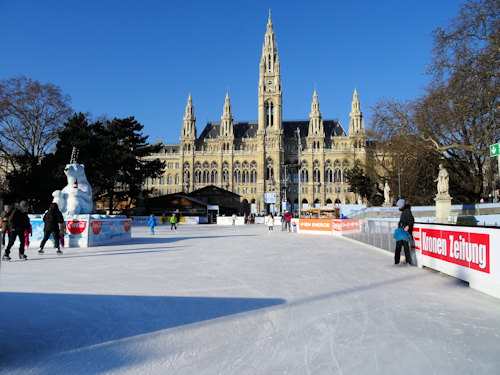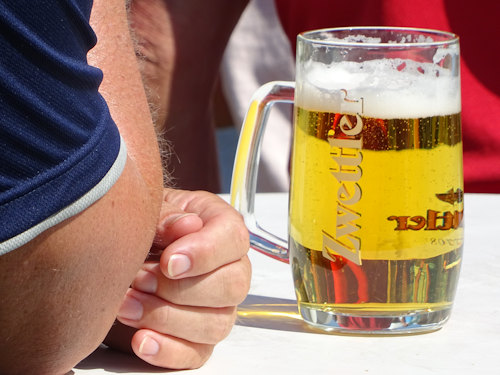
Vienna has a typical dry continental climate, with warm summers and cold winters.
- Winters have been milder of late, though
- But can still get notably chilly
- Summer seems to get longer each year
- All just my perception, of course
- Book a tour experience* for your trip
- See also:
I’m not really going to say much else, because the climate seems rather capricious at the moment, and many other websites provide proper detailed fact-based weather numbers if you’re interested.
For example, this page at the Vienna government site has a lot of local weather statistics, if you’re happy with a bit of German (or use Google translate).
What to expect in winter

(Open-air ice skating in winter at the Wiener Eistraum)
The coldest months are probably December to February, when some days can see temperatures struggle to get much above 0°C (32°F).
Temperatures in February 2024, for example, varied from a minimum of -0.2°C (31.6°F) to a maximum of 15.7°C (60.3°F). That was another unusually warm one.
The worst I’ve experienced personally in around 30 years was around -15°C (5°F), which was way back in the early 1990s.
My perception is recent winters do seem to be milder than normal (cough…global warming…cough).
These months are also when you’re most likely to encounter the occasional snow day.
This is Austria, though, where babies emerge from maternity wards with skis strapped to their feet. Even lowland Vienna continues to function pretty much as normal when it snows.
For example, the local authorities and house owners clear the sidewalks and roads remarkably quickly, and public transport is rarely troubled (though delays can occur).
Tip: If you’re driving, take care where you park if heavy snow is predicted – the snowploughs can end up half-burying your vehicle in snow, leaving you to dig your car out by hand.
If you’re planning to come during winter (perhaps for the lovely Christmas markets), then obviously check the forecast and be prepared to bring warm clothes, including some kind of hat or headband to protect the ears.
Consider sturdy boots or walking shoes should you wish to wander around on foot. The streets and pavements can get mucky after snow, and grit and salt can do unpleasant things with your shoes if you haven’t got the proper footwear.
What to expect in summer

(A cold beer on a hot day)
The hottest time of year is July and August. “Comfortably warm” is a typical description for the summer, but this is a city, so it might get sticky at times. We can have quite a few days where it gets up above 30°C (86°F).
In August 2023, for example, temperatures varied from a minimum of 10.8°C (51.4°F) to a maximum of 36.2°C (97.2°F).
The warm summers mean you can sit outside long into the evening in the gardens or streets outside the cafés, bars and Heuriger (wine taverns). For the record, Vienna also has a number of excellent Italian ice cream parlours.
It doesn’t rain too much, but it never hurts to bring an umbrella.